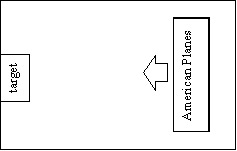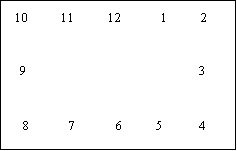 I. PURPOSE
I. PURPOSE
- A. To create a game with an unescorted daylight bombing raid over Germany as the theme.
B. To create rules that can be adapted for solo wargamers or multiple players.
C. To provide a fast, simple scenario to serve as an introduction to the rules or to be expanded to a larger game.
II. EQUIPMENT
- A. Ping-Pong table
B. Small model airplanes (metal 1/285, or paper)
- 1. German: 4 Me-109’s or FW-190’s
2. Americans: 4 B-17’s
C. 2 D6 dice (different colors); 18” ruler; small bits of gravel for marking measurements; black, gray, or brown pipe cleaners. (The pipe cleaners should be cut into lengths of 2” or less, bristles trimmed on one end, and bent back to place around the wings or rudders of damaged planes. A bomber with two damage points would have two pipe cleaner pieces attached to represent smoke trailing from each damaged engine.)
D. A paper rectangle 11 inches wide and 8 inches deep representing a target and AA emplacement.
III. ORGANIZATION
- A. Fighters enter the board in sections (or elements) of two.
B. Fighters may separate for single combat anytime after entering the board.
IV. OBJECTIVES
- A. The American bombers must score three bomb hits on the target to win the game.
B. The German fighters must attempt to destroy all of the American bombers to prevent the bomb run.

V. PLACEMENTS
- A. Placing the target on the board
- 1. The target should be placed on the end opposite to the American entry.
2. The target should be centered on the edge of the board (see Figure 1).
B. Placing American units on the board
- 1. All American bombers and fighters should be placed on the board in an area no farther than 18” or nearer than 6” from the edge of entry.
2. Bombers should be no closer than 6” to the flank edges of the board (see Figure 1).
3. Bombers must be placed in a diamond-shaped box formation. The distance between the tail of the leader should be no closer than 4“ from the nose of the last plane. The right wingtip of the bomber on the left should be no closer than 4” from the left wingtip of the bomber on the right.
C. Placing German fighters on the board
- 1. A German element of two fighters will enter the board on the turn that it rolls an even number on 1 D6.
2. Roll 2 D6 for each arriving element to determine the point of entry on the board.
3. Direction of entry is determined by matching the dice roll with the corresponding numbers on a clock face (see Figure 2).
D. Determine the altitude of fighters at the beginning of the game.
- 1. When German fighters are placed on the board, roll a die to see if the section is above, below, or level with the bombers.
2. Roll 1 D6: 1, 2= below; 3, 4= even; 5, 6= above.
3. Place a coin beside the fighter elements that are above or below the bombers. Turn the coin to heads if the plane is above and tails if the plane is below.
4. The distance of the first move by the fighters will be determined by their altitude.
- a. If a plane is above the bombers, add 6” to the regular move to signify a dive.
b. If a plane is below the bombers, subtract 6” from the regular move to signify a climb.
c. If a plane is level with the bombers, move a regular move.
d. All subsequent moves are the regular distances.

VI. ENGAGEMENT
- A. German fighters automatically move to intercept the closest bombers.
B. Movement
- 1. Me-109, FW-190= 14”
2. B-17= 10”
C. Maneuvering
- 1. Fighters
- a. Fighters must move straight ahead for 6" before turning.
b. Fighters may turn any direction to fly the remainder of their movement.
c. A damage point reduces the final movement of fighters by 2".
2. Bombers
- a. Bombers must move straight ahead 3” and then may change direction up to 90 degrees for the remainder of their movement.
b. Movement for a bomber is reduced 2" for each damage point
3. An airplane must move the entire movement distance before the end of the move.
- a. A fighter may stop at any point to fire at a target, but it must continue its movement after receiving defensive fire from the bomber.
b. Before stopping to fire, measure the complete distance of movement and place a marker (a pebble) at the projected end of the move. If the fighter is damaged by defensive fire, reduce the movement by 2”.
D. Combat
- 1. Offensive values
- a. fighters = 3
b. bombers = 1
2. Defensive values
- a. Me-109, FW-190 =2
b. B-17=3
3. Fighter attacks
- a. The attack range for planes is 4” or less.
b. A fighter may attack one time during its movement turn.
c. If a fighter is attacking directly head-on or from directly behind the target, add 1 point to the offensive value of the attacker.
4. Resolving attacks
- a. Roll 1 D6 for the attacker and 1 D6 for the defender.
b. Add the attacker's offensive value to the number rolled and the defender's defensive value to die number rolled.
c. If the defender's score is equal to or more than the attacker's, there is no damage.
d. If the defender's score is less than the attacker's score, but not doubled, an engine is damaged—or, if all the engines are already damaged, the plane is destroyed.
e. If the defender's score is less and doubled or more by the attacker's score, the plane is destroyed.
5. Bomber defense
- a. Bombers engage in defensive fire following an attack. ( Fighters have no defensive fire.)
b. Bomber defense is conducted in the same manner as fighter attacks (VI.D.4) with the bombers’ machine gunners considered the attackers and the fighters as the defenders.
c. Bombers may not stop during movement to attack a fighter, but they may fire at the end of a move.
d. Each B-17 has four machine gun positions: nose gunner, right waist gunner, left waist gunner, and tail gunner. Firing distances should be measured from the gun positions on the bomber.
e. Waist gunners may not fire simultaneously with the nose or tail gunners at the same target.
f. B-17’s may fire whenever an enemy plane stops within the 4” firing range of a machine gunner; or, when the bomber ends its move within 4” of an enemy fighter.
g. Enemy fighters may be fired at when they stop to attack and again when they stop at the end of their move. (For example, the tail gunner could fire during the attack and the nose or waist gunner could fire at the end of the move. Gunners on other bombers also may fire if within 4.”)
h. A bomber which is destroyed by a fighter is removed immediately with no defensive fire allowed.
VII. THE BOMB RUN
- A. More than one bomber may be over the target on a bomb run at the same time.
B. The entire fuselage of the bomber must be over the target rectangle in order to drop bombs.
C. Bombers receive four 1 D6 rolls for bombs whether the aircraft is damaged or not.
D. Bombing hits are determined in the same manner as combat hits (see VI.D.4)
- 1. To determine if the bomber is hit by flak before it can drop its bombs, roll 1 D6 for the bomber and 1 D6 for the target’s AA
emplacement. (The AA firing range extends 6” from the edge of the target.)
- a. If the bomber's score is equal to or more than the AA’s, there is no damage and the bomb run continues.
b. If the bomber's score is less than the AA's score, but not doubled, an engine is damaged—or, if all the engines are already damaged, the plane is destroyed.
c. If the bomber's score is less and doubled or more by the attacker's score, the plane is destroyed.
2. To determine bomb hits, the bomber and the target each roll 1 D6.
- a. If the target's score is more than the bomber's, there is no damage.
b. If the target's score is less than the bomber's score, but not doubled, 1 bomb hits.
c. If the target's score is less than the bomber's score and is doubled or more, 2 bombs hit.
3. Three bomb hits are required to win the game for the Americans, anything less is a victory for the Germans. Three bomb hits represent minor damage to the target, four hits represent moderate damage, and five or more hits represents major damage.
VIII. ENLARGING THE GAME
- A. The game may be enlarged by doubling the number of fighters and bombers.
B. Two boxes of four bombers each should enter the playing area side by side. All of the other rules apply.
Suggestions for making paper models
1. Print the graphics on paper heavier than regular printing stock. Something near the thickness of an index card will do nicely. The heavier Bristol paper found in art stores works well (the model is almost indestructible), but thicker paper is more difficult to cut with scissors.
2. Score all of the planes on a page before you begin to cut them out. Use a stylus or a dried up ballpoint pen to score where the wings and stabilizers bend away from the fuselage. The B-17 will be bent through the fuselage. Score it on the thin black line that runs from the nose to the tail.
3. Use rubber cement to glue the models together. If you put cement on both sides before joining them, the bond will be much more secure. If you have an excess of rubber cement, the models will tend to stick to one another. An inexpensive rubber cement pick-up (crepe-latex) shaped like an art gum eraser may be bought in art stores. This will remove most of the dried excess very quickly and easily. (09-08-01)
The links below provide the graphics that you will need to print in color (all the notes on this are above). You can copy the graphics and paste onto a new page in order to minimize the number of pages you will have to print.
More World War II: B-17 Scenario and Rules
Back to The Gauntlet No. 22 Table of Contents
Back to The Gauntlet List of Issues
Back to Master Magazine List
© Copyright 2001 by Craig Martelle Publications
This article appears in MagWeb (Magazine Web) on the Internet World Wide Web.
Other military history articles and gaming articles are available at http://www.magweb.com